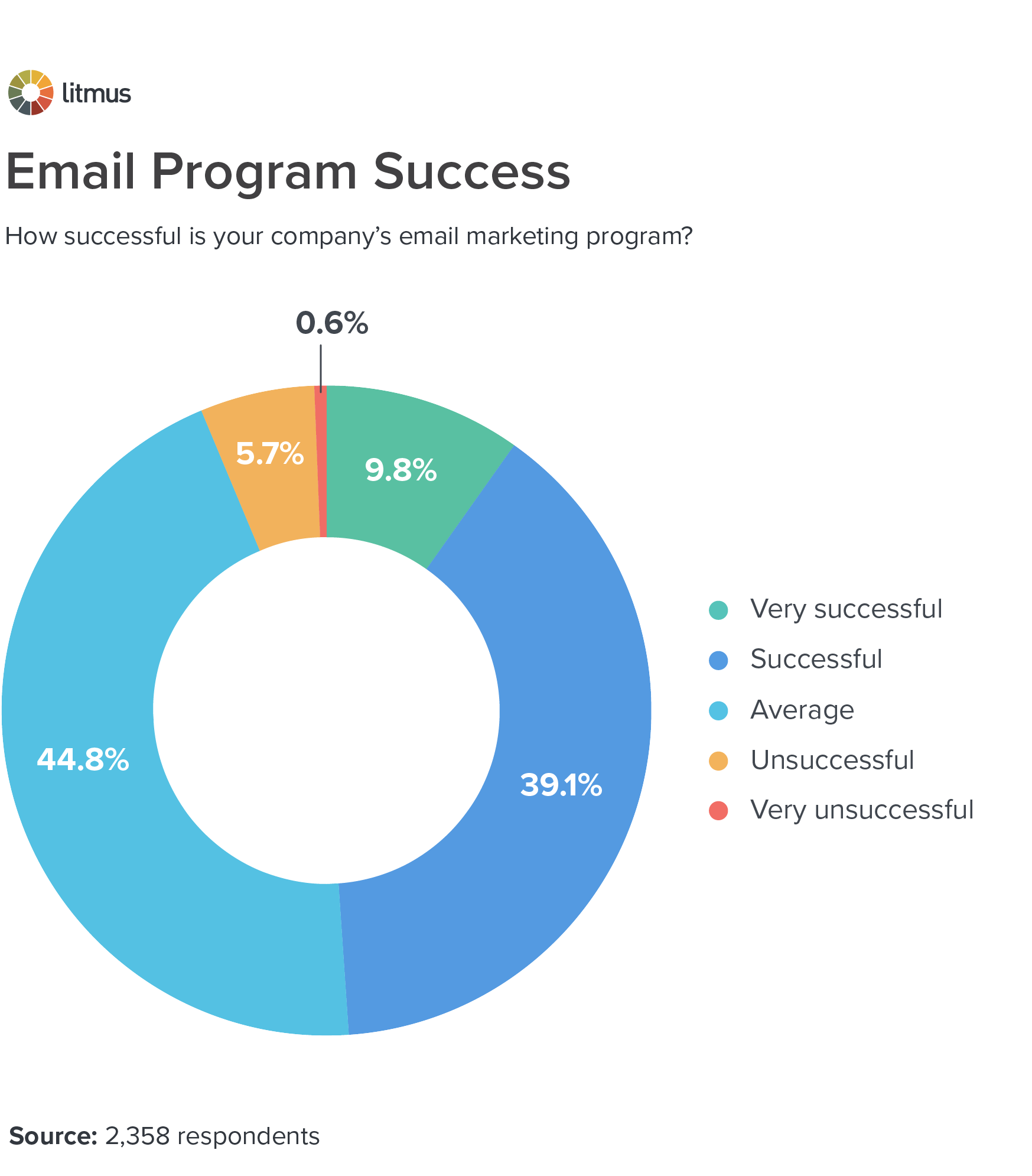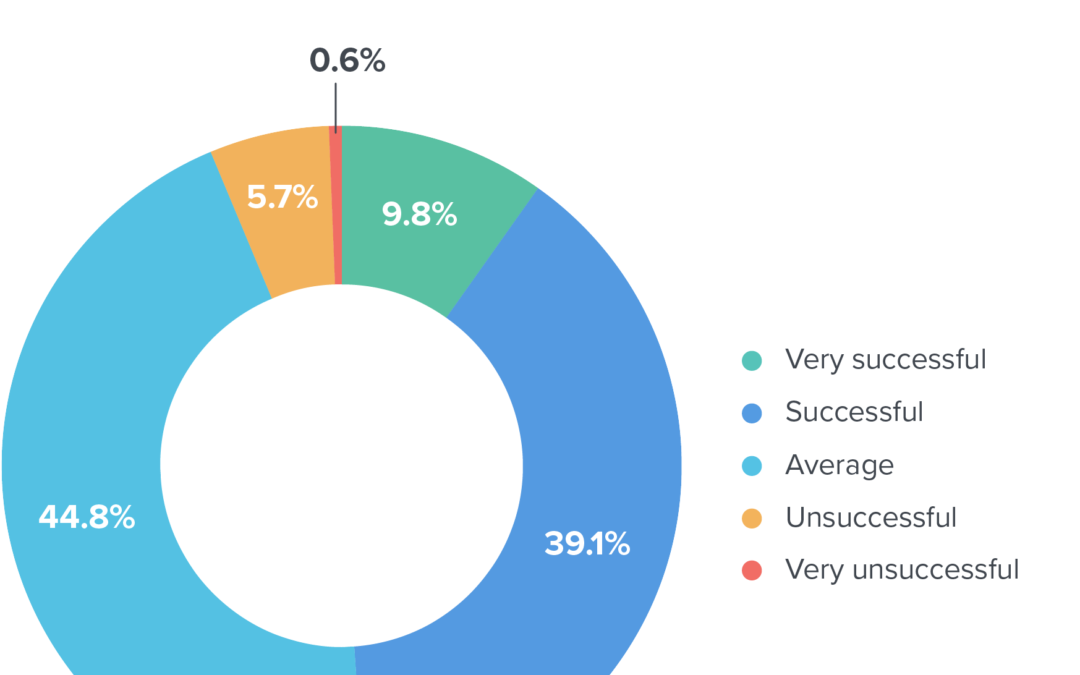While it’s difficult to fail at email marketing, success can be elusive. Shifting consumer behaviors and expectations, new technologies, improving cross-channel integration, changing anti-spam and privacy laws, evolving inbox provider capabilities—all can make getting ahead a huge challenge.
Less than 10% of marketers say their email programs are very successful, according to Litmus’ State of Email Research Series. The majority say their email programs are average or even unsuccessful.

It can be difficult to know how to take your email program up a notch. What changes should you make? What technologies should you leverage? How can you improve your organization?
We can help. Based on our survey of more than 3,500 marketers worldwide, we’ve identified 20 operational, strategic, and technological differences between successful email marketing programs and less successful ones.
Here are the 20 things that successful email marketing programs do more often than others:
– SLIDESHARE TRANSCRIPT –
To better understand email marketing practices and trends, Litmus surveyed marketers worldwide about their email programs. We asked everything from organizational structure and planning to design and deliverability.
More than 3,500 marketers took our survey. They represented companies large and small across a wide range of industries around the world. Their email programs also experienced varying degrees of success.
In this presentation, we identify some of the biggest operational, strategic, and technological differences between the marketers who described their email marketing programs as successful and those who described theirs as average or unsuccessful.
These insights build upon the findings from Litmus’ State of Email research series of reports, which include:
1. Pre-Send Checklists
Emails have many individual elements that can go wrong, including rendering, functionality, links, analytics tracking, and images. Using an extensive pre-send checklist ensures you don’t miss something critical.
Successful email marketing programs are 132% more likely than less successful programs to use an extensive pre-send checklist as part of their QA process (28.1% vs. 12.1%).
For more, check out The Ultimate Email Checklist: 24 Things to Check Before You Send or get a guided check of all critical elements of your email with Litmus Checklist.
2. Email Briefs
What is the goal of your email? Who is it being sent to? When will it be sent? How will success be measured? An email brief answers these questions and more to ensure that everyone on the team is aligned and focused.
Successful email marketing programs are 123% more likely than less successful programs to create an email brief for every email they produce (24.5% vs. 11.0%).
For more, learn How to Define the Goal of Your Next Email Marketing Campaign—and be sure to download the free Email Campaign Planning Workbook.
3. Automated Emails
Triggered emails are highly relevant because they’re sent at a time when recipients are most receptive to the message, which also tends to be personalized. This makes their ROI multifold higher than mass emails.
Successful email marketing programs are 109% more likely than less successful programs to generate at least half of their email marketing revenue from automated and transactional emails (17.1% vs. 8.2%).
For more, read 5 Ways to Make Your Triggered Emails More Effective This Holiday Season.
4. A/B Test Transactional Emails
Transactional emails tend to have much higher open rates than other emails. This gives you a golden opportunity to promote related products and seasonal items, as local laws allow. A/B testing is the key to determining what works best.
Successful email marketing programs are 95% more likely than less successful programs to A/B test their transactional emails at least once a year (33% vs. 17%).
For more, read 4 Ways to Optimize Your Transactional Emails.
5. Email Encryption
Opportunistic TLS and other forms of secure transport encryption protect email content while it’s in transit. It doesn’t affect deliverability yet, but it’s becoming a trust factor thanks to Gmail flagging emails that aren’t encrypted.
Successful email marketing programs are 91% more likely than less successful programs to encrypt their emails (24.6% vs. 12.9%).
Learn more by reading about The Biggest Email Marketing Trends in 2017.
6. A/B Test Automated Emails
Triggered emails are not “set it and forget it” programs. They are “review and improve” programs. Since they are living campaigns, they benefit from updates and optimizations, which includes A/B testing.
Successful email marketing programs are 70% more likely than less successful programs to A/B test their automated emails at least once a year (43% vs. 26%).
For more, read Nothing in Email Marketing Is ‘Set It and Forget It.’
7. Dynamic Content
Thanks to machine learning, better data integration, and other improvements from email service providers, personalization has become much easier. Including dynamic content that’s geared toward specific subscribers boosts ROI significantly.
Successful email marketing programs are 68% more likely than less successful programs to use dynamic content always or often in their emails (50% vs. 30%).
For more on the future of personalization, download Email Marketing in 2020.
8. Win-Back Campaigns
You want your subscribers to convert regularly. Triggering a win-back campaign based on a lack of purchases over a certain time frame is a smart way to help ensure that your customers stay committed to your brand.
Successful email marketing programs are 60% more likely than less successful programs to send win-back campaigns (50.5% vs. 31.5%).
For more, check out 3 Emails to Send Now to Improve Your Holiday Campaign Results.
9. Re-engagement Campaigns
Inbox providers penalize your deliverability if too many of your subscribers aren’t opening your emails. Re-engagement campaigns, triggered by a lack of opens, is a great way to help maintain subscriber engagement.
Successful email marketing programs are 53% more likely than less successful programs to send re-engagement campaigns (55.5% vs. 36.2%).
For more, read 3 Steps to Successful Subscriber Reengagement.
10. Animated GIFs & CSS Animation
Visual movement is powerful. Animated GIFs and CSS animation are the most reliable ways to introduce movement into your emails and catch your subscribers’ attention.
Successful email marketing programs are 52% more likely than less successful programs to use animation at least sometimes in their email designs (53% vs. 35%).
For more, read A Guide to Animated GIFs in Email.
11. DMARC
Working with Sender Policy Framework (SPF) and DomainKeys Identified Mail (DKIM), Domain-based Message Authentication, Reporting & Conformance (DMARC) protects emails from being spoofed and boosts deliverability.
Successful email marketing programs are 50% more likely than less successful programs to use DMARC (54.5% vs. 36.3%).
Learn What DMARC Is + How It Helps Protect Your Brand Against Email Fraud.
12. Styled ALT Text
Adding ALT text to your images is a tried-and-true way to ensure your email conveys its message when images are blocked. Take that to the next level by using CSS to change the font, color, size, style and weight of your ALT text.
Successful email programs are 50% more likely than less successful programs to always or often use styled ALT text (26.6% vs. 17.7%).
Learn more in our Ultimate Guide to Styled ALT Text in Email.
13. Email Content Calendars
Advance email planning is essential to effectively handling seasonal spikes in email sending, creating a complex one-off email, and updating and maintaining existing automated email campaigns. A calendar makes that happen.
Successful email marketing programs are 47% more likely than less successful programs to maintain an email content calendar year-round (63.4% vs. 43.2%).
For more on email planning, download the 2017 State of Email Workflows.
14. Email Address Verification
Typing errors, bad transcriptions, and bots are just some of the reasons that invalid email addresses would be added to your list. Email address verification checks new addresses and flags bad ones before they cause you problems.
Successful email marketing programs are 45% more likely than less successful programs to use an email address verification service (34.7% vs. 23.9%).
For more, check out Email List Hygiene: How to Build a Clean Email List.
15. Pop-Up Signup Forms
Annoying? Many would say yes. However, there’s ample evidence that these in-your-face email signup forms work. Set frequency rules and A/B test different form fields and messaging to minimize annoyance.
Successful email marketing programs are 42% more likely than less successful programs to use a lightbox, exit intent pop-up, or similar form on their website or app (38.0% vs. 26.7%).
For more, read The 5 Most Problematic Subscriber Acquisition Sources: Are they redeemable?
16. A/B Test Marketing Emails
If you’re not A/B testing your broadcast and segmented emails, you’re not fully listening to your subscribers. You’re also sacrificing ROI. ESPs have made A/B testing much easier recently, so there’s no excuse not to test more.
Successful email marketing programs are 32% more likely than less successful programs to A/B test at least a quarter of their broadcast and segmented emails (71% vs. 54%).
For more, learn How to Use A/B Testing to Send Better Email Campaigns.
17. Email Approval Process
An appropriately rigorous approval process means that it’s thorough enough to catch mistakes, but loose enough to not slow things to a crawl. The more email you send, the more critical this becomes.
Successful email marketing programs are 32% more likely than less successful programs to have an appropriately rigorous approval process rather than a burdensome process or one that’s too lax (68.6% vs. 52.1%).
For more, check out 4 Signs Your Email Approval Process Is Hurting Performance.
18. Spam Filter Testing
What if you could identify potential deliverability issues before you send an email? Spam filter testing allows you to do that, catching authentication, content, and other problems pre-send.
Successful email marketing programs are 24% more likely than less successful programs to run spam filter tests to identify problems before sending their emails (61.0% vs. 49.3%).
Learn how to Make It to the Inbox—Not the Spam Folder—with Litmus Spam Testing.
19. Purging Inactives
Endlessly emailing subscribers who aren’t opening your emails hurts your engagement rates and increases your chance of hitting a recycled spam trap, both of which hurt your deliverability. Removing inactives is the solution.
Successful email marketing programs are 24% more likely than less successful programs to remove chronically inactive subscribers from their active lists (59.0% vs. 47.6%).
For more, learn How to Manage the 3 Kinds of Inactive Email Subscribers.
20. Additional Analytics
Having more data on how your subscribers are behaving helps you better target them with personalized content. Better data also informs your overall email design approach and email marketing strategy.
Successful email marketing programs are 23% more likely than less successful programs to use additional analytics to supplement what’s provided by their ESP (68.0% vs. 55.5%).
For more, check out 5 Ways You Can Use Email Analytics Data to Power Segmentation.
Plus…
Successful email marketing programs are more likely than less successful programs to use…
 |
Be More SuccessfulJoin more than 250,000 brands that trust the Litmus Email Creative Platform to help them send better email. |
The post 20 Things Successful Email Marketing Programs Do appeared first on Litmus Software, Inc..

